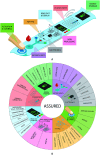The potential of paper-based diagnostics to meet the ASSURED criteria
- PMID: 35548839
- PMCID: PMC9086909
- DOI: 10.1039/c8ra06132g
The potential of paper-based diagnostics to meet the ASSURED criteria
Erratum in
-
Correction: The potential of paper-based diagnostics to meet the ASSURED criteria.RSC Adv. 2018 Nov 12;8(66):37841. doi: 10.1039/c8ra90082e. eCollection 2018 Nov 7. RSC Adv. 2018. PMID: 35560562 Free PMC article.
Abstract
Paper-based diagnostics have already revolutionized point-of-care approaches for health and environmental applications, by providing low-cost, disposable tools that can be utilized in remote settings. These devices typically consist of microfluidic, chemical, and biological diagnostic components implemented on paper substrates, towards addressing the ASSURED (Affordable, Sensitive, Specific, User friendly, Rapid and Robust, Equipment free and Deliverable to end users) principles set out by the World Health Organization. Paper-based diagnostics primarily contribute to the affordable, equipment-free, and deliverable-to-end-user aspects. However, additional functionality must be integrated with paper-based diagnostic devices to achieve truly ASSURED solutions. Advances in printed electronics provide a fitting foundation for implementing augmented functionality, while maintaining the affordability and disposability of paper-based diagnostics. This paper reviews the printed functional building blocks that contribute towards achieving this goal, from individual printed electronic components to fully integrated solutions. Important modules for sensing, read-out of results, data processing and communication, and on-board power are explored, and solutions printed on flexible or paper-based substrates for integration with paper-based diagnostics are considered. Although many of the unit operations required to achieve the ASSURED criteria can be implemented using paper, basic system functionality is still lacking, and this requires a concerted effort in integration of the various components for truly ASSURED solutions to be realized. Beyond ASSURED, modern clinical practises and crisis readiness also require additional informational functionality, which a systems approach using paper-based solutions could ensure.
This journal is © The Royal Society of Chemistry.
Conflict of interest statement
There are no conflicts of interest to declare.
Figures














Similar articles
-
Nanozymes in Point-of-Care Diagnosis: An Emerging Futuristic Approach for Biosensing.Nanomicro Lett. 2021 Sep 13;13(1):193. doi: 10.1007/s40820-021-00717-0. Nanomicro Lett. 2021. PMID: 34515917 Free PMC article. Review.
-
REASSURED Multiplex Diagnostics: A Critical Review and Forecast.Biosensors (Basel). 2022 Feb 16;12(2):124. doi: 10.3390/bios12020124. Biosensors (Basel). 2022. PMID: 35200384 Free PMC article. Review.
-
Paper based diagnostics for personalized health care: Emerging technologies and commercial aspects.Biosens Bioelectron. 2017 Oct 15;96:246-259. doi: 10.1016/j.bios.2017.05.001. Epub 2017 May 1. Biosens Bioelectron. 2017. PMID: 28501745 Review.
-
ASSURED Point-of-Need Food Safety Screening: A Critical Assessment of Portable Food Analyzers.Foods. 2021 Jun 17;10(6):1399. doi: 10.3390/foods10061399. Foods. 2021. PMID: 34204284 Free PMC article. Review.
-
An origami electrical biosensor for multiplexed analyte detection in body fluids.Biosens Bioelectron. 2021 Jan 1;171:112721. doi: 10.1016/j.bios.2020.112721. Epub 2020 Oct 12. Biosens Bioelectron. 2021. PMID: 33091685
Cited by
-
Study of Mechanical Response of Paper-Based Microfluidic System as a Potential Milk Tester.Micromachines (Basel). 2023 Jul 6;14(7):1380. doi: 10.3390/mi14071380. Micromachines (Basel). 2023. PMID: 37512691 Free PMC article.
-
Combining Electrochemiluminescence Detection with Aptamer-Gated Indicator Releasing Mesoporous Nanoparticles Enables ppt Sensitivity for Strip-Based Rapid Tests.Angew Chem Int Ed Engl. 2021 Dec 6;60(50):26287-26297. doi: 10.1002/anie.202110744. Epub 2021 Nov 9. Angew Chem Int Ed Engl. 2021. PMID: 34595818 Free PMC article.
-
Triboelectric Effect Enabled Self-Powered, Point-of-Care Diagnostics: Opportunities for Developing ASSURED and REASSURED Devices.Micromachines (Basel). 2021 Mar 22;12(3):337. doi: 10.3390/mi12030337. Micromachines (Basel). 2021. PMID: 33810006 Free PMC article. Review.
-
Activatable G-quadruplex based catalases for signal transduction in biosensing.Nucleic Acids Res. 2023 Feb 28;51(4):1600-1607. doi: 10.1093/nar/gkad031. Nucleic Acids Res. 2023. PMID: 36727464 Free PMC article.
-
Current Advancements and Future Road Map to Develop ASSURED Microfluidic Biosensors for Infectious and Non-Infectious Diseases.Biosensors (Basel). 2022 May 20;12(5):357. doi: 10.3390/bios12050357. Biosensors (Basel). 2022. PMID: 35624657 Free PMC article. Review.
References
-
- Chang J. S. Facchetti A. F. Reuss R. IEEE Journal on Emerging and Selected Topics in Circuits and Systems. 2017;7:7–26.
-
- Khan S. Lorenzelli L. Dahiya R. S. IEEE Sens. J. 2015;15:3164–3185.
Publication types
LinkOut - more resources
Full Text Sources

